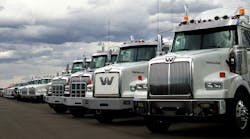Although it's significantly wider and offers more interior room than the Columbia and Century Class, it will eventually replace, the new Cascadia Class 8 on-highway tractor is more aerodynamic, offering a 3% improvement in fuel economy, according to Freightliner Trucks. Introduced in early May, the Cascadia has begun production at Freightliner's Cleveland, NC, plant, with the first deliveries to customers scheduled before the end of this year.
The Cascadia's all-new cab was engineered to accommodate higher cooling requirements for the next generation of low-emissions diesel engines, while also improving driver comfort and lowering operating and maintenance costs, according to the manufacturer.
Freightliner says engineers spent 2,500 hours developing the Cascadia in its custom wind tunnel built specifically for Class 8 vehicles, cutting aerodynamic drag by 20% compared to previous models.
“Our wind tunnel was constructed expressly for this kind of new model development,” says Chris Patterson, president & CEO of Freightliner LLC.
The OEM says the Cascadia will easily accept EPA '07 emission engines and adapt “with little change” to the upcoming EPA '10 standard. The tractor has a larger front-end to accommodate a larger capacity radiator — up to 1,755 sq.-in. — needed to sufficiently cool EPA '10 engines. The Cascadia was built to be optimized with the all-new EPA '10-ready Detroit Diesel heavy-duty engine family, which will debut later this year. The tractor also features an expandable electronic platform that can accommodate '10 emissions-related technology, including SCR (selective catalytic reduction).
Enhancements to ensure the Cascadia stays out of the shop include: improved diagnostics, low-maintenance HVAC system, breakaway side extenders, an optional roped-in windshield that can be changed within minutes, extended-life headlamp bulbs, and easy access to the engine with accessory components mounted to it.
Driver satisfaction and productivity were a major design focus, evident by the completely redesigned cab, featuring more room, automotive styling, ergonomic controls, and plenty of lighting and storage space.
Responding to the increase in the average size of today's truck drivers, the seats are larger, with more room between the seats. The all-new cab also has larger door openings, more head and belly room, and easier-to-use switches and climate controls. Despite the wider cab profile, Freightliner says it cut interior noise and vibration with double door seals, improved engine and cab mounts, and full cab insulation, as well as better air flow over and around the cab and windshield.
The 455-hp. Detroit Diesel Series 60 engine is the standard powerplant, while an MBE 4000 with ratings of 370 to 450 hp. and Caterpillar C15 with ratings from 435 to 550 hp. are available as options. An EatonFuller manual transmission is standard, with UltraShift and AutoShift transmissions available as options.
Other key specs include: rack and pinion steering; GVWRs of 35,000 to 71,000 lb. with a GCWR of 92,000 lb.; standard front taperleaf suspension rated at 12,000 lb. and an optional spring suspension rated at 14,600 lb.; and a standard rear AirLiner suspension rated at 40,000 lb., with optional AirLiner suspension rated at 21,000 lb.
Early next year, the Cascadia will get an optional fully integrated battery-powered auxiliary HVAC system that will provide sleeper temperature control for up to 10 hours without engine idling.
Although the Cascadia will eventually replace Freightliner's Columbia and Century Class models, the company says it will continue producing those models “for the foreseeable future.”
www.freightliner.com


